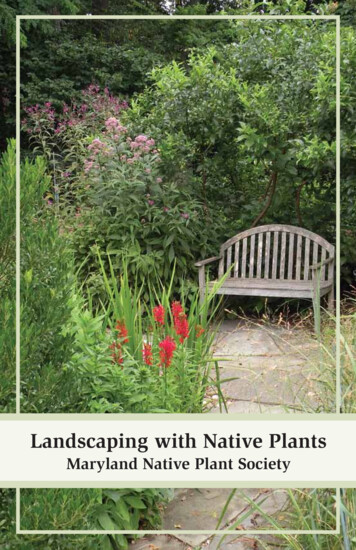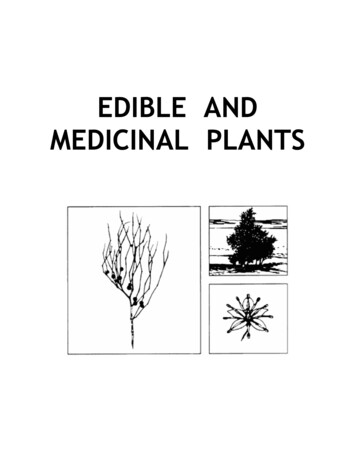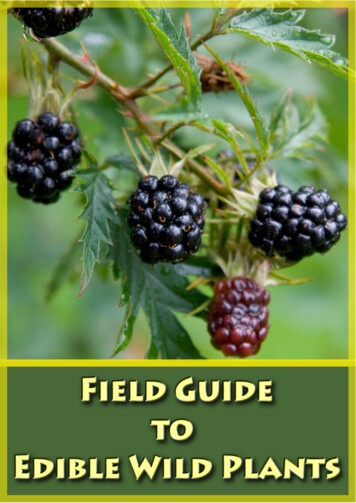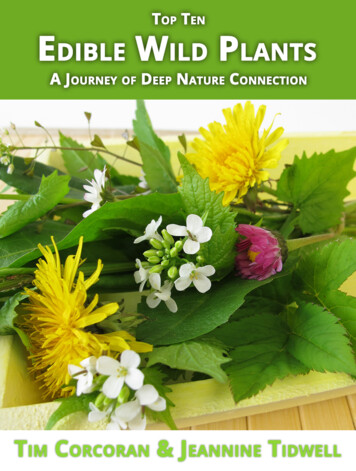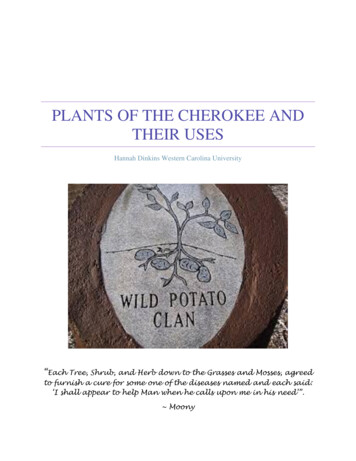
Transcription
PLANTS OF THE CHEROKEE ANDTHEIR USESHannah Dinkins Western Carolina University“Each Tree, Shrub, and Herb down to the Grasses and Mosses, agreedto furnish a cure for some one of the diseases named and each said:‘I shall appear to help Man when he calls upon me in his need’”. Moony
History between the land and the Cherokee peoplethe past, present and future.HistoricallyThe Cherokee lands were comprised of eight states which ranged as far north asKentucky and as far south as Georgia and expanded as far east and west as North Carolina toTennessee. The Cherokee people believe they have lived in this region of the AppalachianMountains since the beginning of time, because to them all life began here. The original mothertown was known as Kituwah, it determined where all Cherokee life and law came from.Scientifically, Archaeologist thought the Cherokee people have been evident in this area for 1200years, which coincided with the Barren Straight theory. However, current archaeologist digshave provided them with artifacts which support that Cherokee people have been here for at least1400-1500 years.The Cherokee people historically had a close vital connection to the land. Cherokee dietconsisted of a diverse amount of plants, plants were used for foods, medicine and clothing.Cherokee people never had any domesticated animals except for a dog, this was due to how wellthey managed their natural resource and landscape. The landscape would be manipulated andmanaged to make mosaic green-ways that allowed them easy availability to animals for huntingpurposes, most of their hunting grounds were in Kentucky and Virginia. Fire was also used as amanagement tool and was present on the landscape at least once every ten years if not morefrequent. It has been said Cherokee forestry was far superior to today’s National park forestrythat is used.Cherokee connection to the land was attributed by their view and appreciation for it, tothem the land was their everything. Cherokee saw the land as something similar to a deity, whichis why they performed dances and ceremonies that gave thanks back to the land. Differentaspects of the land were used for everyday life from housing, clothes, medicine, food, and itswhere they raised their children. Cherokee believe if it wasn’t for their strong connection to,they would not be here. There has always been a connection between the land and the Cherokeepeople. Cherokee people have a very strong tie to the land not only for how they used theirnatural resources but also the appreciation of those. They viewed every aspect of nature to havelife, which not only included plants and animals but also the rocks and streams as well. Everyaspect was believed to have a voice. Everyone’s voice was the same and valued because itsustained the Cherokee, this was true in the natural world as much as it was true in their civilizedculture. The youngest child’s voiced opinion mattered just as much as an elder.Many Cherokee people contribute their longevity and presence on the landscape becausethey view the earth as their home. They would pray by the water. Since the Cherokee viewed theearth not only as their home but also as their mother, they regarded her with reverence andbelieved if you took care of mother, she would take care of you. The Cherokee people believeddeeply in their connection that they came from the earth and when they die, they will be returned
to the earth, which is why when they are buried they are buried in a fetal position on their sideand painted in red paint to signify the blood of the earth. Cherokee word Tohi means “the rightway”. How “the right way” relates to the Cherokee culture in the essence is taking care of theland and their relationship to it. One rule that would sum up Tohi: only take what you need notwhat you want. They wanted to conserve their resources for the next generation and their future.It was the understood rule among the Cherokee people that when you were searching for a plantor other resource you needed, you always passed up the first source of what you were looking forand collected the second source you found. This ensured them the first source would be there forthe second generation. This gave way to their belief in sustainable harvesting, where theCherokee people only took what they needed to support themselves and their families.Sustainable harvesting was accomplished by allowing their crops and natural resources from theland to be evenly disbursed and grown across the landscape.In Cherokee society their roles and cultural stores reflect their beliefs of the land.Agriculture and managing their native vegetation were viewed as shared responsibilities. One ofthe seven clans, known as the Wild Potato Clan, were the keepers of seed for the next year’scrops. These responsibilities were associated with women due to Selu. Selu was the cornmother, and she also gave beans and squash from her body to the Cherokee people. These threecrops, corn, beans and squash, are known as the three sisters. Women were protected and highlyvalued because of their ability to create and give life. The Cherokee nation was a matriarchalsociety. Women were the heads of households, heads of villages, and had roles of belovedwomen, war women, and Clan mothers which had the ultimate say. While Kanati which wasSelu’s husband was known to be the great hunter and provider. This determined men’s roles insociety, which were to be sustainable hunters providing game and strength when going war. Menwere seen to be more expendable. The ways of the Cherokee didn’t believe theprovider/sustainer of life (man) should be separated from the giver of life (woman).Current dayIn reality if you think about the Cherokee people and their first interaction and experiencewith European settlers was in 1500s. It took European 300s to reach the western side of theAppalachian Mountains, but it only took Europeans 100s year to get from there to the PacificOcean.Cherokee people first contact with Europeans was in 1540 when Hernando DeSoto’sexplored the southeastern United States. As more settlers began to come west into theAppalachian Mountains and trade and intermarriage between the Cherokee and English, Scotsand Irish became prominent. Areas in North Carolina became trading posts among different areassuch “Middle Towns" along the Little Tennessee River, the "Valley Towns" along the Hiwasseeand Valley Rivers, and the "Out Towns" on the Tuckasegee and Oconaluftee Rivers. This wasthe First time the Cherokee broke their idea of sustainable harvest was with traders. They wouldhunt enough deer to collect however many pelts they needed in order for them to stack up to theheight of a rifle/musket. This begin to be common with other resources that traders desired suchas herbs and other plants. The amount of unsustainable harvesting led to decline of the Cherokeepeople because they lost their food sources and the large areas that contained them and they were
not enough to match the mass of people in the Cherokee nation who were in need. The Cherokeebegan to break with their connection to the land when European colonization arrived.Colonization broke the connection the Cherokee people had with their traditional foods and usesof plants. The Cherokee would make deals with the government which resulted in themsystemically losing their lands or settlers constantly encroached on it which then reduced theboundary lines ever slowly. This was seen as a result of the French and Indian war during 17541763 and the American Revolutionary war (1775-1783) when the Cherokee sided with theBritish. Even though the Cherokee assimilate with European culture and has a written languagefrom Sequoyah, they were forced out of their homelands. Treaty of New Echota in1835 wassigned by a group of few Cherokee leaders that agreed to relocate the entire Cherokee Nation towestern lands where some of the tribe had already relocated. Roughly 16,000 Cherokees wereforced travel the six to seven-month journey known as the trail of tears to “Indian Territory” inOklahoma. However Principal Chief John Ross refused to sign the Treaty and urged theCherokee people to stay in their homelands, which they did by fleeing into the mountains waitingfor the right moment to emerge and rebuild their lives. Descendants of the Cherokee that fledinto the mountains make up the Eastern Band of Cherokee Indians that live within the Quallaboundary which is comprised of five Counties of Western North Carolina.Today many of their descendants today still do feel a connection to the land. It is fairlyrecently that the Cherokee people do not know the traditional foods during the 1920s-1930s.There is a self-conscious connect the Cherokee people have to the land, today people many goaway for college or work for two to three years but always find their way back to their homeland.They want to preserve their native lands and its natural resources to what they traditionally had.Some young people are wanting to go back to the Cherokee way and want to know how to useplants in their traditional way or reincorporate their traditional heritage and uses of the land backinto their lives.The reason so many European settlers wanted to settle and claim the lands of the Cherokeewas because they saw how vital and plentiful it was as a natural resource. However todayCherokee people live different lives, but their ancestors instilled the Cherokee ways in then bytelling stories to make sure they “do the right way” or Tohi. When Cherokee people go to theirsacred sites, they can’t help but feel and energy and connection there to their native homelands,such as Clingmans dome is where everything was given them. While some Cherokee peoplehave a connection to the land other feel like they have lost their connection to the land but wishthey still had it, while others feel like it has evolved. Cherokee people’s relationship with theland varies because it is a limited connection. Some people were brought up Christian and somestill believe in the old ways of the Cherokee, while others believe parts of both and others arelearning to about it. There some Cherokees that are going back to their old ways. As youngerCherokee people have gotten older, they have begun to gain an appreciation for the Cherokeeways as they have gotten older. Many Cherokees wish old ways would be here now because itwould be a better way of life than what they have now. The Cherokee people have a bittersweetlonging for their homelands back, they drive in these mountains and think how beautiful andbreathtaking an area is and are let with the thought of “this use to be ours”. Today the Cherokeepeople are buying back their land one piece at a time. Cherokee see it as a way of getting a pieceof their sacred land back, many of the places they buy back are sacred to them and they want to
preserve it not develop it. The Cherokee people have the sense of responsibility to preserve andprotect the lands they view as sacred.
Ferns of the Cherokee
(Picture 1)(Picture 2)Common and Scientific Names: Dennstaedtia punctilobula, Hay-scented fern (Picture 1),Thelypteris novaboracensis, New York fern (Picture 2)Scientific family: Dennstaedtiaceae – Hay-scented fern, Thelypteridaceae-New York FernCherokee Name: egû lĭ uwásgilĭCherokee meaning(s): New York ferns gets their name from uwásgilĭ meaning ‘soft’.Theses ferns were known as ‘soft’ ferns due to the softness of the leaves or fronds, whileigû lĭ uyela‛a means naked and igû lĭ dawiskage translates to smooth ferns. Hay-scented fernscan also be known as yân-a utsĕ sa, usdíga meaning the bear lies on it or small.Uses:Both types of fern are under the same name egû lĭ uwásgilĭ or ‘soft fern’. These fernswere the most potent remedies for heart troubles; however, other ferns were useful for thiscondition. Egû lĭ uwásgilĭ was a component of a medicine used to treat “the Big Chill” ormalarial fevers.
Plants of the Cherokee
(Picture 3)(Picture 4)(Picture 5)Common Name: Large yellow lady’s-slipper (Picture 3), Small yellow lady’s-slipper (Picture 4),Pink lady’s-slipper (Picture 5)Scientific Name: Cypripedium calceolus var. pubescens, Cypripedium calceolus var.parviflorum, Cypripedium acauleScientific Family: OrhidaceaeCherokee Name: k‛kwĕ ulasúlaMeaning of the Cherokee Name: ‘partridge shoe’The Cherokee name, K‛kwĕ (‘partridge’) Ulasúla (‘shoe’ or ‘moccasin’), has the samebasis as the common name lady’s-slipper. This is due to the pouch-like sac which looks like ashoe, moccasin, or slipper.Uses:It is believed the Cherokee didn’t differentiate between the pink and yellow variety or thelarge and small variety of the yellow. Pink lady slipper roots were boiled into a thick decoctionand given to children for worms. Both varieties were collected and sold to white traders. Thepink lady slipper was used for stomach cramps when it was combined with a species of Sanicula.Lady slipper roots of were made into a tea for nervous conditions, kidney problems or it wascombined with Comandra umbellate. A tea from these roots could be used for “femaleproblems” such as menstrual irregularities and menopausal changes. Four whole plants wereused to create a tea which was said to relieve hernia pain in men and women. A root tea of thelarge yellow variety had many applications including colds and flu, kidney problems, nervousconditions, high fevers, and stomachaches. All three types of roots could be made into adecoction and drunk for diabetes.
Common Name: Spotted wintergreenScientific Name: Chimaphila maculataScientific Family: EricaceaeCherokee Name: ustăstĭ usdígaCherokee Name meaning: ‘he spins’, ‘small’Uses:The root of spotted wintergreen was used to make a tea to treat colds, flu, and fever.Wintergreen roots could be beaten, used as a poultice for headaches and other sources of pain, ormade into a tea for menstrual pain. Utastĭ ustí leaves pounded and wrapped in a cloth which wasthen soaked in water to bathe the eyes of patients who had sore eyes and couldn’t look at the sun.
Common Name: Yellow-rootScientific Name: Xanthorhiza simplicissimaScientific Family: RanunculaceaeCherokee Name: dalâni amayułtehiMeaning of the Cherokee Name: ‘yellow, water edge growing’This plant got its’ name Yellowroot by the intense yellow color that was apparent whenthe bark is removed from the stem and roots which allowed them to receive the name Dalâni(Dalânige). The next part of yellowroots Cherokee name is Amayułtehi which mean ‘water edgegrowing’, this refers to the preferred habitat of this species which is commonly found growingnear mountain streams.Uses:Yellowroot produces a bloody juice called Atat‛aski which is an important medicine inthe Cherokee. Dalâni amayułtehi was used as a decoction and was blown on the head, breast, andpalm of each hand of a birthing mother. It could be used to cure for when they were urinatingblood or diarrhea. The roots were used by steeping them, then holding them in their mouth tocure thrush. Scraped off bark poultice could be used to relieve sore eyes. By chewing on theroots or an infusing, it would alleviate a sore mouth. The roots could also be added to muttontallow to create a salve. Roots made into a tea would calm nerves or alleviate cramps. If Dalâniamayułtehi was combined with Asarum canadensis, Goodyera pubescens, Alnus serrulata, andPrunus serotina it was used as a blood tonic and would increase the appetite. However,Yellowroot didn’t just only have medicinal properties but was used as the primary source ofyellow dye to color white oak baskets, masks, bows, and other objects. Earlier in the 19thcentury it was used with black oak bark to color ceremonial feathers to turn them “a mostbrilliant yellow”.
Common Name: Wild gingerScientific Name: Asarum canadenseScientific Family: AristolochiaceaeCherokee Name: nuyagûlĭ Meaning of the Cherokee: ‘it climbs the rocks’Wild ginger’s Cherokee name comes from nû ya meaning ‘rock’ or ‘stone’ and gûlĭ meaning ‘it climbs’ which is another form of tsĭlahĭ or tsĭlĭ ‘I am climbing’, this refers to itsability to grow on moss covered rocks.Uses:A hot infusion made out of bruised roots was used for coughs, or the root could bechewed. The roots of nuyagûlĭ’ was also dried for future use. A formula using the leaves wereused with Alnus serrulata, Carpinus caroliniana, and Sassafras albidum for old sores andcancers. It was also used for aninedzi ada‛nöwoti tuksinigöwayö nategsöi (‘their breast, to cureanyone with, terrapin does it to them, as they go about’), aninedzi gotiski (‘their breast swells’),and yöwi tsunstia göwani skastane‛öi (‘when the little people frighten them’). Wild ginger wasalso used for milky urine. Sores in the abdominal region were treated with roots made into adecoction and blown over the afflicted region with a tube. Nuyagûlĭ was an herb sold forcommerce to white herb buyers. Roots and A. canadense would be made combined into a teaconsumed for heart trouble, menstrual irregularity, and colds. A decoction of heartleaf combinedwith Goodyera pubescens, Alnus serrulata, Prunus serotina, and Xanthorhiza simplicissima wasused for a blood tonic and to improve the appetite. Dried leaves of wild ginger were also used assnuff, while fresh leaves were used for healing wounds.
Common Name: Jack-in the-pulpitScientific Name: Arisaema triphyllumScientific Family: AraceaeCherokee Name: túyastĭ Meaning of the Cherokee Name: ‘a boil or carbuncle’The name “Indian” in Indian turnip was used to mean “counterfeit” or “treacherous”which was similar to terms as “Indian giver” or “Indian summer”, meaning the plant wasconsidered poisonous when consumed.Uses:However, the roots would be “boiled to remove the strong smart taste, and then mashedwith the hands, mixed, or kneaded like dough and then baked or fried like other dough. Jack-inthe -pulpit roots were dried along with a small quantity of walnut bark pounded together andplaced in the center of a boil (known as tústĭ). Turpentine collected from pine trees and used asointment along with the pounded herbs, which was covered with cloth or paper until it washealed. Turpentine from pine tree was used as an ointment to heal a wound so it wouldn’t leavea scar. Túyastĭ roots would be made into a poultice for headaches. Roasting roots for short timeand then rolling into small grape sized balls would be eaten. Anywhere from 2, 3, 4, or 7 of theballs would be eaten at a time for kidney problems.
Common Name: LiverleafScientific Name: Hepatica acutilobaScientific Family: RanunculaceaeCherokee Name: skwálĭ usdí-gaMeaning of the Cherokee Name: ‘small liverleaf’The Cherokee name for liverleaf stems from the word uskwâ lĭ meaning ‘stomach’.Uses:Roots and leaves were chewed or made into a tea for a person with a cough. Liverleafleaves or roots would be combined with Asplenium rhyzophyllum made an emetic or a decoctionthat was boiled down to ½ its volume for a person who dreamed of snakes. Skwálĭ usdí-ga wasused for other conditions such as aninedzi ada‛nöwoti tuksinigöwayö nategsöi (‘their breast, tocure anyone with, terrapin does it to them, as they go about’), aninedzi gotiski (‘their breastswells’), and yöwi tsunstia göwani skastane‛öi (‘when the little people frighten them’). Adecoction of could be made and consumed during a new moon to prevent whooping cough.Skwálĭ usdí-ga roots were used as hot tea for bowel complaints, while dried leaves could be usedfor heart troubles. Dried crushed leaves of Liverleaf were made into a tea for toothaches.Liverleaf was also harvested and sold to white traders, due to the demand in the herb market fortheir leaves.
Common Name: Solomon’s sealScientific Name: Polygonatum biflorumScientific Family: AsparagaceaeCherokee Name: uganástĭ útanaMeaning of the Cherokee: ‘sweet, large’Uses:Solomon’s seal is the most important food from this folk genus. Solomon’s seal receivesits name from the Cherokee word utístŭgĭ or utĭstkĭ meaning ‘hanging head’ due to the pair offruits hanging below the arched stalk. The young shoot of Solomon’s seal was eaten as greens.The root can be pounded by a corn mortar and added to bread, as a famine food. Uganástĭ útanaroots were roasted and pounded to be applied to boil-like swelling. It could be made into a teaand consumed for stomach problems as well. Solomon’s seal roots and P. biflorum malongmixed with soil gathered from the front of a ground hog’s den, were combined and boiled tomake a decoction which was consumed as a medium for emesis to clear “spoiled saliva” due todreams of the dead. The patient would vomit until all the liquid was expelled; this would berepeated for four straight mornings. Uganástĭ útana was also used for a purple form of acancerous condition known as ada‛yeski (‘eating itself’).
Common Name: May-appleScientific Name: Podophyllum peltatumScientific Family: BerberidaceaeCherokee Name: uniskwetú‛gĭ tsundí-gaMeaning of the Cherokee Name: ‘they wear a hat, or they have their heads covered, small’Uses:May-apple roots were combined with black walnut and butternut bark and made into astrong decoction, which was boiled down four times until it became a thick syrup. Half a teacupfull would be consumed at one time as a powerful cathartic. It was thought the patient wouldrecover at once unless a menstruating woman entered the room, and if they did the patient wouldswell up and die. May-apple was used for unisi‛kwaskö (‘when they are coughing’) and acondition related to dalâni, uniskwotłii tsunitłöyö yuwot‛isö andanawoski (‘when they have astomach-ache with swollen and throbbing stomach’). Dried powered roots of Uniskwetú‛gĭtsundí-ga or a tea made from them, served as a laxative. Another common use for the roots wereto soak them in whiskey and take them for rheumatism. Pounded roots were also soaked inwater, and combined with soaked corn seed, resulting in a tea to keep pests from eating thefreshly planted corn. A single drop of juice from the root was place in the ear to cure deafness.Some people warned others to only use the portion of the root between the nodes, because thenodes themselves were too poisonous. Nodes were specifically used to poison crows and dogs.More conservative Cherokees would avoid the plant all together, believing any vine plant in theirgarden would wither and die if they tended to their plants after eating the fruit. However, Mayapple fruits are edible.
Common Name: Bear-grassScientific Name: Yucca filamentosaScientific Family: AsparagaceaeCherokee Name: sĕlikwâ yaMeaning of the Cherokee Name: ‘green snake’The leaves of button snakeroot resemble the leaves of the rough green snake, which ishow it received its Cherokee name sĕlikwâ ya.Uses:Medical conditions such as amayiutsistano utsya (he is sick by the water’), göwanigistöi(‘when they are eaten by them’), (an‛t‛asgiski tskoya – ‘insects are breaking out’), useski(‘whooping cough’), uwanu‛söçiça dalânige (‘gonorrhea’), and uyoi ani‛ayölöçi (‘when theyhave inhaled bad odors’) could be treated with Bear-grass. A decoction would be made andgiven to children as a preventive measure against whooping cough and other contagious diseases.It was one of the three ingredients in a sacramental drink for the Cherokee version of the GreenCorn Ceremony. Roots and leaves of sĕlikwâ ya were soaked in water and drunk by patients withdiabetes. The pounded roots were used for two purposes, washing blankets and as a fish poison,because of the high saponin content in the roots.
Common Name: Cardinal flowerScientific Name: Lobelia cardinalisScientific Family: CampanulaceaeCherokee Name: tsâliyústĭ gígagéĭMeaning of the Cherokee Name: ‘like tobacco, red’Uses:Cardinal flowers were used for adansiludoi yune‛istanelö (‘trailing along, if there is painin different places’) or unestanelidoloçöi or uneistaneo gananugotsidoi (‘when they have painsall over their body’). Uses for other similar conditions such as aniskina göwani‛tsö istöi (‘whenthey have been made sick by dead persons’), aniskina uniyaktanöçi (‘ghosts have changed (thecondition of the patient)’), ayeligogi uniyelö‛nöçi (‘they have made it like it’), and gegane‛sagöçi(‘they have it caused by plotters’). Tsâliyústĭ gígagéĭ was used for a condition called gigöyandik‛öça (‘urinating blood’). This plant was also used to stop nose bleeds, but it was oftencombined with L. siphilitica to make a cold infusion from the roots and leaves and then snortedup the nose. A decoction from the leaves could be consumed to reduce fevers.
Common Name: BloodrootScientific Name: Sanguinaria canadensisScientific Family: PapaveraceaeCherokee Name: gílĭ wă taMeaning of the Cherokee Name: ‘dog’s penis’The Cherokee meaning of gílĭ wă ta comes from the appearance of the plant’s roots.Uses:Gílĭ wă ta roots were pounded to relieve pain from an aching tooth. Blood root was alsoused as a plant dye for a red dye to masks, bows, baskets and ball sticks. This dye was favoredby basket makers to make a “rich, fast color” and was not matched by any other dyes. The besttime to collect the roots for dying would be to harvest them in late summer. The plants wouldhave little dye value if gathered in early spring. Gílĭ wă ta roots were soaked in cold water to beused as a cough medicine, while the powdered dried root could be used as a snuff for mucuscongestion.
Common Name: Large flowered trilliumScientific Name: Trillium grandiflorumScientific Family: MelanthiaceaeCherokee Name: a‛yöda gwalogiMeaning of the Cherokee Name: ‘it thunders (habitually)’Trilliums Cherokee name references ‘thunder and lightning’ in reference to the mythicallittle red men whose conversations from the Darkening land cause the rumble of thunder fromthe west.Uses:Trillium (T. grandiflorum) was collected and sold to the herb traders. Roots from all thedifferent varieties were steeped in cold water and consumed for four days for gaktûta. The mainsymptom of gaktûta was spitting blood. The symbolism of the red-flowered trilliums mayindicate they were preferred remedies. A‛yöda gwalogi was also used in childbirth to aid inexpelling the placenta.
Common Name: White violetScientific Name: Viola striataScientific Family: ViolaceaeCherokee Name: dindáskwatéskĭ unega adsilû skĭMeaning of the Cherokee Name: ‘they pull each other’s heads off, white flowered’Uses:White violets were also used as part of the remedy for ada‛yeski (‘eating itself’). Poundedroots could be held against an aching tooth to make the bad tooth fall out. A cold tea could bemade out of dindáskwatéskĭ unega adsilû skĭ to stop vomiting. The roots also contained a bluedye for dying fabrics.
Common Name: Green coneflowerScientific Name: Rudbeckia laciniataScientific Family: AsteraceaeCherokee Name: satsû nnăUses:Green coneflower has many dialect forms, but the middle dialect form is satsû nnă.Conservative individuals of the Cherokee who consumed the greens picked early in the spring,parboiled them three to four time and changed the water and then they were cooked in grease.Roots of satsû nnă were boiled down to make a thick syrup which would be placed in the earwhen someone had an earache. This plant was often transplanted into gardens for easy access.
Common Name: Marsh blue violetScientific Name: Viola cucullataScientific Family: ViolaceaeCherokee Name: dindáskwatéskĭ tsundí-gaMeaning of the Cherokee Name: ‘they pull each other’s heads off, small’Uses:Marsh blue violet was used to make a poultice from its’ pounded roots, leaves, or both todraw a boil to a head. Dindáskwatéskĭ tsundí-ga was another type of violet remedy for canceroussores known as ada‛yeski (‘eating itself’).
Common Name: Yellow VioletScientific Name: Viola pubescensScientific Family: ViolaceaeCherokee Name: dindáskwatéskĭ dalânige adsilû skĭMeaning of the Cherokee Name: ‘they pull each other’s heads off, yellow-flowered’Cherokee reference to tsíswate‛skû means ‘I am pulling his head off’ anddastadaskwtĕskû , ‘we two are pulling each other’s heads off’ is because how the flower appearsto dangle on the stalk and dalânige adsilû skĭ means‘yellow-flowered’.Uses:Dindáskwatéskĭ dalânige adsilû skĭ was used as a remedy for a type of cancerous soresknown as ada‛yeski (‘eating itself’).
Common Name: Pink smartweedScientific Name: Polygonum pensylvanicumScientific Family: PolygonaceaeCherokee Name: uhyû stĭ or uhyû stĭ unéga adsilû skĭMeaning of the Cherokee Name: ‘bitter’, ‘white-flowered bitter’Uses:Pink smartweed or Uhyû stĭ as it is known to the Cherokee was considered to be morepeppery than bitter. This plant was pounded and placed in pools to poison fish. Uhyû stĭ was alsocrushed or cooked up as a liniment for bruises or painful joints, since this plant had a pepperynature it was used to prevent thumb sucking by children.
Common Name: SedgeScientific Name: Carex spp.Scientific Family: CyeraceaeCherokee Name: ganága tsăninahitaMeaning of the Cherokee Name: ‘it has been licked’Cherokee considered sedges to be grasses.Uses:Carex sp. was used for the nightmarish condition inadö danskitsöi (‘when they dream ofsnakes’).
Common Name: Yellow wood sorrelScientific Name: Oxalis strictaScientific Family: OxalidaceaeCherokee Name: tsuntsâ y’stĭ útanaMeaning of the Cherokee Name: ‘it is sour, large’Uses:Yellow wood sorrel was used for unöłstay‛ti tsuniyotc‛eça (‘when their appetite getsspoiled’).
Common Name: GalaxScientific Name: Galax aphyllaScientific Family: DiapensiaceaeCherokee Name: nuyagûlĭ usdí-gaMeaning of the Cherokee Name: ‘it climbs the rocks, small’Galax got its Cherokee name from its ovate/round leaves.Uses:A tea could be made out of the roots for kidney problems.
Common Name: Rattle Snake plantainScientific Name: Goodyera pubescensScientific Family: OrchidaceaeCherokee Name: N/AUses:Rattle Snake plantain was used to strengthen the blood, the formula for this consisted ofP. serotina, Xanthorhiza simplicissima, Goodyera pubescens, Asarum canadensis, and Alnusserrulata. A decoction of X. simplicissima
valued because of their ability to create and give life. The Cherokee nation was a matriarchal society. Women were the heads of households, heads of villages, and had roles of beloved women, war women, and Clan mothers which had the ultimate say. While Kanati which was Selu




